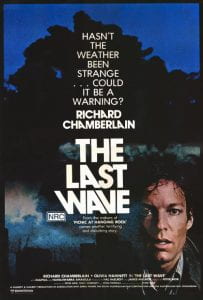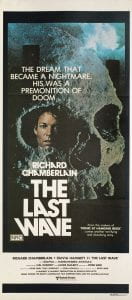
The outback hailstorm scene in The Last Wave
Some ideas for an ESL-EFL class on extreme weather, with clips from The Last Wave and Magnolia
Please excuse the title of the post, Way Out Weather, which is also the name of a very fine album by psych-folk singer-songwriter Steve Gunn. It also serves as a handy shorthand for the increasingly extreme and unpredictable weather we are experiencing at the moment due to climate change.
Near where I live in South East France we are confronted, each summer, with heatwaves of increasing intensity. What was once an occasional phenomenon is now a racing certainty every year, punctuated with storms of an uncommon ferocity. One such hailstorm singled out a small town not far from where I live with stones big enough to smash windows and pockmark cars. All of this is, of course, pretty minor in the greater schemes of things, but I think most people have something to say these days about the changing climate, which is why it makes a stimulating topic for the ESL-EFL classroom.
 One film I watched recently that it particularly evocative for discussions about extreme weather is Peter Weir’s early Aussie New Wave piece The Last Wave (1977). Made after the director’s rightfully celebrated Picnic at Hanging Rock (1975), it is largely forgotten now, but ideal for use in class as it is likely unfamiliar to most students.
One film I watched recently that it particularly evocative for discussions about extreme weather is Peter Weir’s early Aussie New Wave piece The Last Wave (1977). Made after the director’s rightfully celebrated Picnic at Hanging Rock (1975), it is largely forgotten now, but ideal for use in class as it is likely unfamiliar to most students.
The film is by no means a total success, wedding visions of environmental collapse to a neo-noir mystery marred by somewhat orientalist mumbo jumbo about the Aborginal dreamtime. White solicitor David Burton (played by Richard Chamberlain) investigates a murder within Sydney’s aboriginal community during a period of climatic turbulence involving relentless “black rain” (also the film’s original US title). Burton starts to believe that his nightmares of a tsunami-like cataclysm are in fact prescient visions shared by the tribal communities he is himself investigating, foreseen by them in subterranean cave paintings.
That the film was savaged by some critics at the time – and some screenings picketed by aborigines down under – is hardly surprising. Setting asides the questionable representations of indigenous Australians, their customs and beliefs, the film also suffers from some iffy acting and saggy storytelling. It nonetheless features some striking imagery, particularly in Burton’s apocalyptic dreams, which are achieved with relatively lo-fi (compared to today) but evocative effects, some of which have been anthologized here:
I thought one scene in particular from The Last Wave might work as a way of eliciting vocabulary around the theme of climate and extreme weather. The sequence in question is from the beginning of the movie in which an outback school is visited by a violent and unexpected hailstorm (see image at the top of this post). With some judicious chunking to exploit its dramatic shift from Australian desert to an apocalyptic fury of ice and rain, the scene should prove an engaging and inspiring starting point for discussions about the environment and climate change.
A sequence from The Last Wave that is not available to view online is one in which it appears to be raining frogs. This reminded me of another great scene, this time from Paul Thomas Anderson’s Magnolia (1999). In that modern classic – a multi-protagonist meditation on serendipitous happenings and the lasting damage done by dysfunctional parenting – the protagonists are visited by an ostensibly random, almost biblical shower of the said amphibians.
It is a spectacular scene that provides a release of kinds to Anderson’s operatic powderkeg of a movie, and one that is at once comic and brutally visceral. Those frogs hit hard! Moreover it was a scene reportedly achieved with minimal use of CGI, of which I am not a great fan. Like in The Last Wave, the success of the visual effects can be attributed in part to their tangibility, something I rarely feel is rarely evoked with purely digital imagery.
Level: B1+
Warm-up
You could do some brainstorming about different types of weather. Rather than asking for lists of words, you could get students to describe each phenomena in their own words as best as they can.
Clip analysis 1
Step one
Show students the first 1’45” approx. of the following scene, without revealing the title of the film. Ask them to describe what they saw in small groups or pairs, focusing on the following prompts:
- Who? Where? When?
- Describe the environment shown
- What do you think happens next and why?
Once students have had time to share their ideas, sollicit suggestions from the whole class, making a note of useful vocab for everyone to see.
Step two
Show the students the rest of the clip, asking them once again to share their ideas in groups/pairs around the following prompts:
- What happens in the clip?
- How does the scene make you feel and why?
- What do you think the film is about and why?
- What kind of film do you think it is?
- Do you think it is realistic? Why (not)?
Once the students have finished discussing the clip, sollicit suggestions again from the whole group.
Clip analysis 2
Tell the students they are going to watch a second clip, once again witholding information about the film. Repeat the exercise from Clip analysis 1, this time stopping the clip after 40 seconds. Have students discuss the following prompts in small groups/pairs:
- Who? What? Where? When?
- What do you think happens next and why?
Watch the most of the rest of the clip, freeze-framing at 3’30” when the camera zooms into the bottom right hand corner of the painting wherein we see the text “but it did happen”. Have the pairs/groups discuss their observations again, around the following prompts:
- What happens in the clip?
- What do we learn about the characters and how do events affect their lives?
- How does the scene make you feel and why?
- Do you think it is realistic? Why (not)?
- What similarities and differences are there in the two clips?
- Which of the two clips do you prefer and why?
Creative-productive activities for students
You could do one or more of the following follow-up activities:
- Show students the two posters below of The Last Wave. Without researching the film online, ask students to prepare and present an imaginary synopsis for the film using the images, clip and straplines for inspiration.


- Have students research online and present the strangest and most extreme weather phenomena they can find. At least one group could research and present the mythic phenomenon of “raining frogs”.
- Have students imagine and present their own bizarre weather phenomenon, or a scene in a film involving one, preparing a storyboard if necessary.
- Work on one of these extreme weather or natural disaster activities
- Hold a discussion in small groups about weather experiences. Here is an example online
- Hold a climate change debate. Here is an example online
Language focus
- Weather and climate vocabulary
- Phrasal verbs to discuss weather phenomena – like this or like this
- Prepositions of movement
